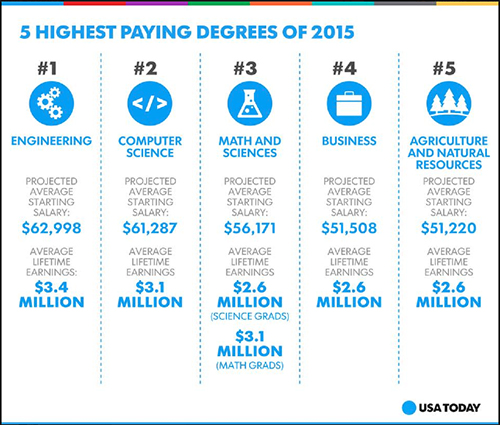According to USA Today, students in the Class of 2015 who pursued an agricultural or natural resources degree and subsequent occupation will be among the highest paid graduates in the nation.
As of 2011, nearly one out of every three people over the age of 25 held a bachelor's degree, according to the U.S. Census Bureau. Furthermore, a bachelor's degree holder typically earns $2.4 million over their lifetime.
In a culture of higher education, the focus has now shifted toward getting the most bang for your buck, or pursing a degree that will lead to ample job opportunities and higher earnings' power.
Below are the five highest paying degrees of 2015 [data were collected from the Census Bureau and an employer survey from the National Association of Colleges and Employers (NACE)]:

No. 1: Engineering – It may seem overplayed, but earnings' data show that engineering majors will likely earn $3.5 million over the course of their lifetime. Within this field, petroleum engineers are expected to have the highest starting salaries at $80,000.
No. 2: Computer Science – Over their career, computer graduates who work in management occupations will earn the most at $3.7 million. Students with a specific discipline or specialty also tend to earn higher wages.
No. 3: Math and Sciences – This year, math and science graduates will earn an average starting salary higher than the typical household income. Physics majors are expected to earn the highest starting salaries this year at nearly $65,000.
No. 4: Business – Business majors may seem a dime a dozen, but they are still earning more than a typical graduate. Those holding management occupations tend to earn the most over the course of their career while service and office support workers earn less.
No 5: Agricultural and Natural Resources – Those who work their way into management positions generally earn the highest lifetime earnings; $800,000 more than the typical college grad.

The author , Amanda Smith, was an associate editor and is an animal science graduate of Cornell University. Smith covers feeding, milk quality and heads up the World Dairy Expo Supplement. She grew up on a Medina, N.Y., dairy, and interned at a 1,700-cow western New York dairy, a large New York calf and heifer farm, and studied in New Zealand for one semester.








